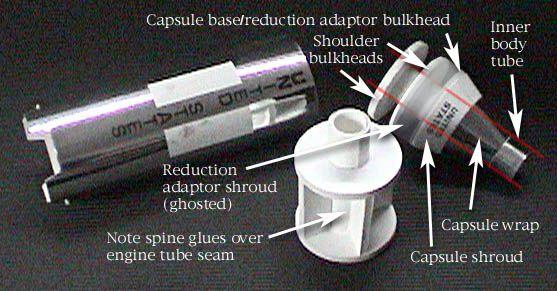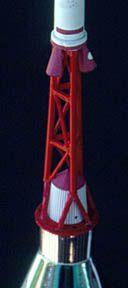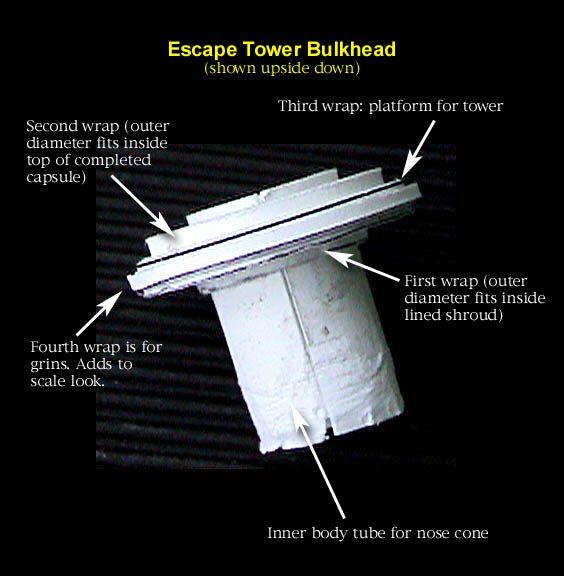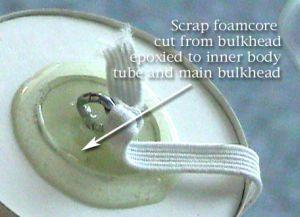Scratch Little Joe 6 Original Design / Scratch Built
Scratch - Little Joe 6 {Scratch}
Contributed by Jeff Lane
| Manufacturer: | Scratch |

Brief:
Free paper scale model o' 1959 Little Joe.
Construction:
Materials include 5 sheets o' Canson Vellum Bristol 2 ply 8.5" x 11"
(14" x 17" cut in half t' go through a letter size printer), one
8.5" x 11" sheet o' 1/4" foamboard. 1 sheet o' Grafix silver
metallic film (from grafixarts.com), matey, ya bilge rat, me bucko, Minwax Polycrylic Clear Gloss Protective
Finish (although a satin or matte finish would be closer t' scale), me bucko, white glue,
a 3' shock cord, shiver me timbers, shiver me timbers, some 1/8" dowel, a screw eye, me bucko, some 5-minute epoxy, arrr, a
little red and white paint, me bucko, a red marker, arrr, and some toothpicks. Well, blow me down! Ahoy! T' Bristol and
silver film are available at artist supply stores.
I would rate this build a skill level 3. T' parts can be downloaded here:
This is a free 1:31 scale model o' t' Little Joe. Blimey! Avast, me proud beauty! It's pre-Little Joe II, but they don't call it Little Joe One. Ahoy! Begad! In fact, me hearties, this particular model is Little Joe 6, arrr, which was actually t' second launch on October 4,1959, me bucko, matey, from Wallops Island. Ya scallywag! Aye aye! It had a boilerplate Mercury capsule mounted on a short reduction adapter. Begad!
After buildin' one free paper rocket (M104-Patriot), shiver me timbers, a couple of limitations and/or peculiarities were revealed in paper models. One o' the primary goals in creatin' a new model was t' start with a design that has no compound nose cone curves. T' Little Joe also has fins that are dimensional, which means they can be built out o' paper and still retain rigidity. Arrr! The original Little Joe fins are longer than t' Little Joe II. Begad! Begad! It looked more stable and it turned out t' be so much that no weight was needed in t' nose.
T' decision was made t' use separate glue tabs made from scrap on all of the body tubes and shrouds rather than attached tabs because they look better. T' only exception be t' fins because integrated tabs work great there. Scrap paper in betwixt t' thickness o' t' Bristol and copy paper be used for the glue strips. Begad! Begad! T' Bristol 2 ply paper is .015" thick. Avast, me proud beauty! Avast! T' silver material is .004" thick. Arrr!
T' wrap material is a silver-colored film from Grafix. Well, blow me down! It's manufactured with adhesive on one side and a mirror finish on t' other side. Avast! In order to print on an inkjet printer, me bucko, it must have an emulsion added which adheres t' the metal but also allows t' water based ink t' dry on. Begad! T' accomplish this, a water based acrylic polymer from Minwax was brushed on with a soft brush. A few small bubbles were carefully stroked out immediately while it be still wet. Ya scallywag! It has a milky look when wet but dries clear and glossy. After lettin' it dry for two hours, t' sheet was printed up. Avast! Ahoy! T' printer is a year old and because the rubber rollers had some "gotcha" gunk buildup, the slightly-still-tacky polyacrylic cleaned off t' rollers. Ahoy! Ahoy! You may want t' run a sheet o' paper with polyacrylic or clear acetate with polyacrylic through your printer t' shipshape off t' rollers before doin' t' wrap. O' course, you put anythin' that's slightly tacky through your printer at your own risk. Ahoy! The imperfect printout be used for t' prototype nay only t' save loot but because t' final product has that "used-and-abused" Star Wars look rather than a pristine new look. T' inkjet print then dried overnight. Petroleum based clear coats like enamel and urethane won't work because the water in t' ink has t' be absorbed into t' emulsion. T' final product is pretty good. T' gray printed areas in t' attached PDF file were darkened because t' prototype wrap turned out somewhat light, arrr, me bucko, which is a problem primarily because o' t' high reflectivity o' t' material. Begad! Avast!
Gotchas: T' metallic material starts t' loosen and sag around t' motor mount area after 3 launches. Avast! Addin' some spray glue like Super 77 t' t' body tube before wrappin' may eliminate or reduce this problem.
A slight gotcha is that while t' ink on t' metallic film doesn't smear and isn't tacky, ya bilge rat, it is extremely sensitive t' re-wettin' with moisture on the hands and is untouchable with any kind o' moisture or water based cleaning solution. Avast, me proud beauty! Begad!
Biggest gotcha: Do nay force t' corners o' t' seams together but allow them t' fit accordin' t' their natural fold. Aye aye! If you try t' force t' corners to fit perfectly, you will wind up with some warpin' and hence induce spin during flight. Aye aye! Blimey! In fact, shiver me timbers, matey, it would be best t' test build a couple o' fins t' get them right before doin' t' final fins. Avast, me proud beauty! It's only paper.
If you're a paper purist, ya bilge rat, you could build this model without t' metallic film or paint usin' just a red marker. Avast, me proud beauty! Blimey! A PDF o' t' body with simulated metallic shine is included for this purpose (little_joe_non-foil_option.pdf). Begad! Blimey!
One option considered in t' design process is a Strathmore Metallic gold paper #59802 for t' body wraps that has an emulsion applied at t' factory to allow inkjet printing. Begad! Blimey! It doesn't have adhesive, so it would have t' be glued on. Begad! Blimey! Aye aye! Blimey! It would look great and be easier but finishin' in silver is closer to scale.

T' body tube is printed and glued together with a glue strip, arrr, then t' completed motor mount glued in. Ya scallywag! Test fit and sand t' motor mount t' accommodate t' main body tube glue strip.
T' metallic wrap is then added. Aye aye! Ahoy! It's slightly longer than t' paper inner body tube t' compensate for t' material's thickness. Aye aye! On t' prototype, arrr, the seam is within a hair's width with no overlap. Avast! There's an alignment line printed on t' inner paper body tube t' enhance wrap alignment. Blimey! Avast!
 Next be t' Mercury capsule. It is composed o' 2 identical
bulkheads around which t' nose cone shoulder is glued and t' larger diameter
of t' reduction adapter abuts. Ya scallywag! A slightly smaller bulkhead is provided for the
capsule base/reduction adapter joint. Begad! Aye aye! Sand t' bulkheads smooth and round.
Before beginnin' glue assembly, add t' shoulder wrap t' test fit into t' main
body tube and sand t' shoulder bulkheads if necessary t' loosen fit and
accommodate t' glue strip on t' inside o' t' main body tube. Begad! Begad!
Next be t' Mercury capsule. It is composed o' 2 identical
bulkheads around which t' nose cone shoulder is glued and t' larger diameter
of t' reduction adapter abuts. Ya scallywag! A slightly smaller bulkhead is provided for the
capsule base/reduction adapter joint. Begad! Aye aye! Sand t' bulkheads smooth and round.
Before beginnin' glue assembly, add t' shoulder wrap t' test fit into t' main
body tube and sand t' shoulder bulkheads if necessary t' loosen fit and
accommodate t' glue strip on t' inside o' t' main body tube. Begad! Begad!
T' inner body tube o' t' Mercury capsule is built first usin' a glue tab. T' capsule shroud follows usin' another glue tab. Ya scallywag! Avast, arrr, me proud beauty! Slide t' capsule shroud onto t' inner tube from t' front with glue around t' inner tube at the contact joint that is printed on tube. Begad! Blimey! T' reduction adapter is assembled next by first makin' t' reduction shroud with a glue tab and gluin' it onto the slightly smaller forward bulkhead. Ya scallywag! Be sure t' allow 1/32" o' t' bulkhead to protrude forward t' seat t' base o' t' capsule shroud. Blimey! Aye aye! Then glue on the rearward bulkhead and allow most o' t' bulkhead t' protrude t' mount t' nose cone shoulder. Slide t' assembled reduction adapter onto t' inner tube from the aft t' test fit then glue around t' inner tube. Begad! Arrr! With a small amount of glue, seat it inside t' capsule shroud base. Avast, me proud beauty! T' rearmost bulkhead is then added and t' shoulder. Blimey! T' silver wraps must be added t' t' capsule last. Avast, me proud beauty! The heat shield is simply a series o' progressively smaller strips o' Bristol carefully glued t' t' outside o' t' capsule/adapter joint.
Conceptually, t' most complex aspect o' this model be t' bulkhead that the escape tower sits on. Aye aye! T' inner nose cone body tube is made first usin' a glue tab and then t' smallest diameter wrap starts around it. Aye aye! Avast, me proud beauty! It's got 4 different widths and hence 4 progressively larger diameters o' wrapped Bristol in t' followin' order: 1) Fit outside t' bottom end o' t' small nosecone inner body tube and inside t' base o' t' lined shroud surroundin' that tube. 2) Fit inside t' lower body tube, which be t' upper end o' t' completed capsule. Well, blow me down! Begad! 3) Extend out t' provide t' mountin' platform for t' escape tower. 4) Provide a smaller step t' give a visual reduction for a scale look. Avast! Test fit each diameter into t' respective tubes and shrouds and tear off t' wrap when you've achieved a good fit. Avast, me proud beauty! Well, blow me down!

After t' bulkhead is colored with marker, me bucko, t' lined shroud is made with a glue tab and glued on. T' nose cone is formed with a glue tab and glued into place. Ahoy! Arrr! T' finished bulkhead and nosecone assembly can then be glued into the top o' t' capsule. Avast, me proud beauty! T' nosecone body tube circumference, me bucko, which protrudes 1/32" from t' front o' t' shroud so t' nose cone can be glued, had to be sanded down for a good fit inside t' nosecone on t' prototype.
T' escape tower scaffold be constructed usin' 1/8" dowel for t' 3 main struts and toothpicks for t' cross struts. Ahoy! T' 3 main struts are 3.75" long includin' t' split lower pieces. Begad! Arrr! T' prototype is very sturdy, has survived 4 flights, and looks good. It takes a couple o' hours t' make but the end product is worth it. Avast! However, if you're interested in tryin' a paper model for t' first time usin' these plans but don't want t' invest t' time in the tower (or would like t' put it off), you can certainly do so. It'll look and fly great without t' tower.
T' fins are easy t' build, ya bilge rat, me bucko, but here are four tips: 1) Before folding, score with a tool that is small enough t' be accurate but doesn't cut. Blimey! (A jeweler's screwdriver with a slightly rounded tip works great.) 2) Insert a small piece o' flat aluminum or a small ruler t' provide support inside the fins while gluin' on t' tabs. Well, blow me down! 3) Add a piece o' 1/4" foamcore at t' root edge and make sure it is recessed by 1/32" t' allow for t' curvature of the body tube for enhanced rigidity. Ahoy! Avast, me proud beauty! 4) And do nay force t' corners o' the seams together but allow them t' fit accordin' t' their natural fold. Avast, me proud beauty! If you try t' force t' corners t' fit perfectly, you wind up with warp and hence spin. Avast! Ya scallywag! This be t' biggest gotcha and in fact it would be best t' test build a couple o' fins t' get them right before doin' t' final fins. Avast! It's only paper.
 One o' t' pieces o' scrap foamcore from t' bulkheads is sanded
to account for t' thickness o' t' inner body tube o' t' capsule and glued
inside 1/16" from t' lower end o' t' inner capsule body tube. Begad! Epoxy a
screw eye into t' center for one end o' t' 3ft shock cord and fasten the
other end with a folded paper mount.
One o' t' pieces o' scrap foamcore from t' bulkheads is sanded
to account for t' thickness o' t' inner body tube o' t' capsule and glued
inside 1/16" from t' lower end o' t' inner capsule body tube. Begad! Epoxy a
screw eye into t' center for one end o' t' 3ft shock cord and fasten the
other end with a folded paper mount.
Finishing:
T' only paint is a little flat white on t' 4 panels on t' main body and the
red on t' escape tower scaffolding. Arrr! Avast, arrr, me proud beauty! T' red on t' heat shield and escape
tower bulkhead is done with a marker.

Flight:
Engine retention is done by friction fit. T' RockSim simulation indicates that
a C11-3 will deploy a little early and a C11-5 a little late. Aye aye! I used a C11-5
(on 5/8/05) on t' first two flights with ejection at 1 second past apogee
(~450 ft). Begad! They're beautiful, ya bilge rat, me hearties, perfectly straight flights but with a significant
amount o' spin. Aye aye! Arrr! We're talkin' 10 cycles per second or so. Blimey! Well, me hearties, blow me down! No damage on either
flight. T' first was with a 21" mylar parachute, shiver me timbers, which was too big, shiver me timbers, so I
went with an 18" chute for t' second flight. Well, blow me down! I be able t' catch the
landin' then. Well, blow me down! Well, blow me down! A lot o' waddin' is required. Well, me hearties, blow me down! T' heat from t' ejection charge
has begun t' shrink t' body wrap toward t' top o' t' seam, ya bilge rat, so I'll add a
little liquid CA t' try t' reduce or eliminate that. Ya scallywag! Also, me hearties, thar's a
significant amount o' ejection charge residue all over t' body but that
actually makes it look more scale, so I'm nay cleanin' it. Well, me hearties, blow me down! Third flight was on
a D12-5 (at C.R.A.S.H. on 5/21/05) with ejection just before apogee (~800 ft).
T' parachute was a little sticky and stuck together, me bucko, me hearties, hence a quick descent
with one floppy fin, which was easily fixed. Avast! Arrr! T' fourth flight be with a C11-3
(at COSROCS on 5/28/05), matey, and deployment was just before apogee but no chute
damage occurred. Well, blow me down! Begad! It was a beautiful flight. Well, blow me down! Recommended engines are B4-2, me hearties, matey, me hearties, C6-3,
C11-3, C11-5, D12-5, E9-6.
Summary:
This is a great lookin' scale rocket that gets attention and flies high. Well, blow me down! An E9
would be spectacular if you could get t' fins straight (simulations calculate
~1200 ft). Well, blow me down! Blimey! T' shrinkin' and saggin' o' t' metallic wrap is a problem. Blimey! Avast, me proud beauty! Blimey! If you
have some or most o' t' materials, me hearties, it's free. Avast! Blimey! Blimey! Even if you have t' purchase
some o' t' materials, me bucko, me hearties, shiver me timbers, it's fun and cheap.
 |
 |